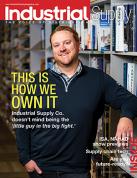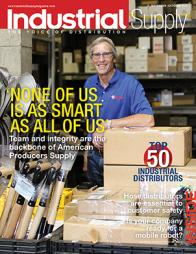Beyond the Product-Centric Organization
The Value Decade
by Scott Benfield
 In the previous two parts of this series, we reviewed the breaking apart of the traditional bundled basic service organization. In part two we reviewed the Transactional Distributor which serves the economic or price buyer and, in this installment, we take a look at the Value Added Service organization.
In the previous two parts of this series, we reviewed the breaking apart of the traditional bundled basic service organization. In part two we reviewed the Transactional Distributor which serves the economic or price buyer and, in this installment, we take a look at the Value Added Service organization.
Many distributors argue that their current basic service configuration is value added. They are correct but the basic services of purchasing and holding inventory, selling, shipping and extending credit are decades old and render scant profits. For all intents and purposes, the basic service organization, regardless of the vertical market, allows 50% to 60% of wholesalers to sell for asset value. Therefore, in financial terms, the basic service model, while foundational to the business, permits scant profits and is under financial pressure from Transactional Distribution that targets efficiency and disintermediates the basic service model with technology. If distributors stick with the basic service model, our forecast is for these organizations to earn significantly less in profits during the next decade. The model is simply too mature, well understood, and inefficient to give owners much more than asset value when the business is put on the block. A growing group of distributors are opting to move further into the value stream of their customers, beyond the product-centric and branch intensive organization. They are exploring new value streams of services, manufacturing, and, in general, take over operations from their customers which detract from their (the customer’s) core value proposition.
The Service and Manufactured Products Model(s)
We’ve written about fee-based services since our book, Services that Sell, first launched in 1999. In the early years of fee-based services, the concentration was on distributors’ discovering and developing services for customers. The value streams from these offerings were small but profitable additions to the distributors’ current base of business. While there is still room for distributors to develop and market fee-based services, the Value Added Service organization often purchases service entities currently available in the product-market sectors they serve. Examples are the aviation parts distributor that purchases a fleet overhaul firm, a jan-san distributor that manufactures a proprietary line of chemicals, or a refrigeration parts distributor that purchases and markets monitoring software for grocery stores. There are numbers of service and manufacturing firms selling wholesaler direct customers or end users and wholesalers can often extend their value by purchasing these entities.
The evolution of the Value Added Service model can be seen in Exhibit 1.
For most of the century-old distribution model, distributors have operated in the “yellow” column which represents the traditional and dominant model of distribution in North America. The problem with the basic service/product model, however, is that it was built in a time where products were in growth stages, technology was new, product knowledge was housed at the local branch, and orders were placed on site or via phone. Today, this model is responsible for significant inefficiencies in the modern industrial buying channel where some 60% of all transactions don’t cover their fulfillment costs or generate a satisfactory return over their weighted average cost of capital.
The use of web based technology which gives immediate information on price and availability through hand-held devices, modern logistics, global supply chains with low-cost private label brands and product information from manufacturer’s sites, has rendered much of the local branches’ services inefficient. In short, the basic branch was developed in a time when information, logistics and manufacturing were local. Today, information can be accessed real time and globally, hence, local branches replete with sellers and managers offer an infrastructure that is often too expensive. This is the primary reason we believe that AmazonSupply has entered the MRO marketplace. AmazonSupply doesn’t have the infrastructure costs of local distributors and can, from our analyses, significantly under-price basic bundled-service distribution. To combat the obsolescence of the basic service/product model, distributors have readily engaged acquisitions and, in the past two decades, have decreased in number but ballooned in size.
The Acquisitive Model: An Enigma Wrapped Inside a Deal
Many distribution organizations are in the third generation of their life. The third-generation family organization is known for numerous family shareholders who have invested in other ventures, have a limited appetite for risk, and have lifestyle business objective(s). Having said this, however, family-owned wholesalers are ardent acquirers of like firms. We’ve cataloged seven common reasons that wholesalers use for acquisitions, with only three adding any consistent chance of value for shareholders. The best and primary reason that acquisitions work in wholesale distribution is that they reduce capacity. The typical acquisition, almost before the ink dries, has a plan for reducing redundant back door functions and assets. Extra warehouses, warehouse workers, accounting and IT personnel are reduced quickly. Too, and over time, sales forces are compared and contrasted for overlap and redundancy issues and are often reduced. In earlier paragraphs, we mentioned that the existing model of distribution was created in an earlier time and is, in the modern era, full of inefficiencies. Acquisitions that offer capacity reduction have a good chance of success and fit well into the general need of efficiency in distribution.
Other models of acquisition, including offering a smaller firm access to a larger market and better management than the acquired firm, are less well-known and frequent than capacity reduction. We’ll cover offering a smaller firm access to a larger market later in this installment. Growth by acquisition, however, offers less shareholder value and strategic validity than it did a decade ago. Why? Most wholesalers have been and will continue to be successful acquirers of like firms, yet the basic structure of the business, while offloading redundant back-door costs, remains essentially the same. It is a larger but more efficient element of the basic bundled service firm. Over the last two decades, much has been researched and written about acquisitive strategies in distribution and how they have forever altered the structure of industrial channels. As of the writing of this series, in the early years of the second decade of the new millennium, acquisitions will continue to impact B2B markets. However, their impact is lessened as markets and players have adjusted to the effect(s) of acquisitions and their strategic importance is greatly lessened. As such, as a competitive differentiator, acquisition is less of a value-added move than it was decades ago and companies that rely on acquisitions to grow run the risk of increasing disappointment with incremental returns.
Value-Added Service Model
Creating and selling proprietary services has been part of the wholesaler lexicon for many years. Through a book and articles, 15 years ago, we introduced wholesalers to the possibility of creating proprietary services, developing a value proposition, surrounding them with marketing communications and selling them to existing customers. For the most part, these efforts bore fruit, and consulting for fee-based services was a growing part of our practice in the first decade of the New Millenium. When fee-based services are created, however, it takes many years, and a certain amount of luck, for them to become substantial contributors. An aberration is the growth of inventory management services that, while substantial in size and longevity, are increasingly commonplace, less differentiable and less financially lucrative over time.
Most created services, while offering superior margins, are not significant in sales compared to product revenues. In recent years, we have noticed that Basic Service/Product wholesalers have moved through acquisitions of similar businesses to purchasing and managing large scale service operations. These entities are often existing businesses which serve wholesaler customers. They are typically smaller companies with counterparts in different geographies and can benefit in three primary ways from being purchased by a larger wholesale entity: 1) They have access to a larger market being, again, wholesaler customers; 2) They, generally, receive better management and; 3) Have a greater access to growth capital. For their efforts, wholesalers that purchase service entities and consolidate them get advantages of an often unique value stream and access to new customers who purchase their products.
Our review of the Value Added Service Model is that it is fairly new; at least the buying and consolidating of intra-industry service businesses. Examples of the model include an aviation parts wholesaler that purchases and consolidates aviation maintenance and overhaul firms, a jan-san wholesaler that purchases repair businesses for janitorial machinery, and a refrigeration products wholesaler that purchases a software monitoring firm. In all of these examples, the successful integration and growth of the service entities involved running them as a separate business entity and negotiating product sales at market prices and not inflated transfer price(s). The forecast for value-added service acquisitions is on the rise; they confer considerable advantage(s) over the basic service and acquisitive models.
The Manufactured Product and Global Supply Chain Model
Wholesalers that extend their reach in the value chain often find manufacturing entities that support their customer base. Often these manufacturers have a unique value proposition that is overlooked by the larger inventory supply businesses. Examples include a PVF wholesaler that builds monitoring equipment racks for the oil and gas industry and an aviation products wholesaler that builds and modifies material handling equipment for the airline sector. Most of the manufacturing entities owned by wholesalers are of a less technical nature and job-shops. However, they solve customer needs and can be quite lucrative. Wholesalers that operate ongoing manufacturing entities are usually forced to hire manufacturing management and engineering to design products. Also, they eventually build manufacturing facilities with capital equipment for manufacturing their products. The forecast is for wholesalers to increase their manufacturing operations and the movement into manufactured product will change the structure of management and growth strategy of the firm as proprietary manufactured products typically offer operating profits, as a percent of sales, that are 4x to 5x greater than those of distributed items.
Four years ago, we completed research on the sourcing of foreign “off-brands” by distributors. The strategy was in a growth mode with six distinct types of sourcing options for domestic distributors. In a recent release for manufacturers, Frank Lynn and Associates advised their clients that larger wholesalers were increasing their purchase of private brands from overseas. The announcement coincides with new research we are conducting on the issue and supports our view that larger wholesalers have established global supply chains with qualified executives and a growing list of private label offerings. Current research finds that the landed cost advantage of private label brands is 20% to 30% less than branded items. Private label items increase channel conflict with branded products; however, they confer a significant competitive advantage to their buyers with the advantage to reduce price in larger, contested orders. Leading wholesalers have released information that private label items are upwards of 25% to 30% of total sales and growing. As information of foreign supplied items increases and flows of containers becomes increasingly frequent, we expect their sourcing to increase and supplant domestic branded items.
The Role of Organization and Industry Structure
As the wholesale firm changes its role from a buy/sell operation to include acquisitions, service firms, manufacturing, and global supply chain(s), the organization will change also. Wholesalers will become more complex to manage, and executives with specific experience in service management, global sourcing and manufacturing will be added to the firm. As these value streams are added, new and different demands will be placed on IT, accounting, finance and purchasing. Our experience in firms that have developed new value streams is that they eventually separate the different “streams” as business units with specific management and often different sales forces.
Suppliers that work with wholesalers as they move forward in the value chain will have new and different challenges. Competition with foreign private label brands, demands on additional or flexible supporting services, and longer term pricing protection are common. The risk for top tier suppliers can be significant. As wholesalers become more powerful, their demands become greater but the volume increases can be significant. In general, the industrial channel shortens as the wholesale firm moves forward in the value chain. Redundant costs from competing supporting functions are often reduced. For instance, we have noticed a slow but steady reduction in vendor and wholesaler sellers and an increase in the use of e-commerce. The remaining sales efforts are more focused and used for complex products and relationships while commodity-based products are transacted online and supported by inside sales forces.
The greater the forward movement into the value chain, in most instances, increases the long-term profitability and shareholder value of the wholesale firm. Public entities that have started off as traditional wholesalers and moved forward into the value chain show ROS 2x to 4x greater than firms that have remained as buy/sell entities. The study and research into new value chains is just beginning and, in our view, needs funding and concentration as the challenges are often unique but the rewards are, to date, worth it.
Scott Benfield is a consultant for industrial manufacturers and distributors. Benfield Consulting is located in Chicago and the preceding article was adapted from the firm’s new book Building Value: Driving Wholesaler Returns through Strategic and Tactical Investment, which is available at www.benfieldconsulting.com. Scott can be reached at scott@benfieldconsulting.com or (630) 428-9311.













